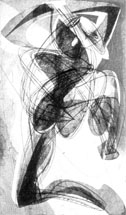|

Comment
on this story
What:
Lines in Motion
Where:
The Knoxville Museum of Art, 1050 World�s Fair Park Drive
When:
April 19, through July 28.
Call 525-6101 for information
|
|

A lesser-known form of abstract expressionism comes to the KMA
by Heather Joyner
Some people might think that the KMA's new Lines In Motion show exemplifies the kind of collection museums exhibit when biding their time. After all, doesn't the golden age of abstract expressionism smack of a been-there-done-that-but-here-we-go-again experience for both curators and art lovers? Yet when I consider much of what currently passes for art (some of which is delightfully trashed by Peter Schjeldahl in a recent New Yorker review of this year's Whitney Biennial), I find art created decades ago more invigorating than ever. Of course Pollocks and de Koonings still ooze genius. But it's stuff that didn't initially blow me away that now intrigues me—like songs I used to skip over when listening to the Beatles' White Album. Fortunately for us, two-and-a-half dozen prints on loan to the KMA from UT graduate Charles Dean constitute a similar concoction of subtlety and drama.
At one point a law student, then later an assistant maitre d' at Manhattan's Carlyle Hotel, Dean began purchasing art a mere 15 years ago. Since that time, the collecting of abstract expressionist prints has gained status, and the diversity and quality of images Dean has brought together is somewhat responsible for the present level of interest. Printed in almost all cases by the artists themselves and released in small editions, works in Dean's collection reflect the improvisational energy and experimentation of their era. However, their spontaneity is not always associated with the reproducible printmaking medium—a factor that's kept prices low and enabled people like Dean to afford them.
Dean's enthusiasm for the prints he collects is due in part to his allowing personal responses to be his guide. Art Dealer Daniel Lienau has assisted Dean and remarks, "He's collected for the purest of reasons, which is that [he's] bought what he likes, not what books have told him to buy." Hirschl and Adler Galleries Director Joseph Goddu says, "[Dean] can walk away from mediocre works by great names." What Dean has not passed by is work by West Coast artists such as Edward Dugmore and Robert McChesney, often ignored by the New York art world. Lienau has compared Dean to California artists themselves, saying that he's "defiant in [his] autonomy." Dean's collection also features works by not-so-famous artists deserving of our attention, and examples of these are included in the exhibit.
The Charles Dean Collection is furthermore a departure from the norm in terms of the medium chosen. Composed entirely of prints—including the only one ever created by Hans Hofmann—it features pieces by artists we associate with other disciplines, as well as images by master printmakers like Peter Grippe and Stanley Hayter. For instance, an intaglio titled The Magic Garden (1953) by sculptor Louise Nevelson is not her usual boxy fare, and seeing it is a bit like getting to hear Ravi Shankar sing. An untitled print from 1970 (the latest date in the bunch) by Hofmann's one-time student Lee Krasner reflects the character of her paintings; like Philip Guston's Wash Shapes (1966), it possesses a simplicity sometimes lacking in her works on canvas. Female artists are well represented, and the range of printing techniques is impressive.
As for printmaking techniques represented, the Lines In Motion exhibit includes unusual approaches as well as more familiar lithography (a West Coast favorite), intaglio, engraving, woodcut, screen printing, and etching. "Soft-ground" etching, for example, employs fabric, "cellocut" involves celluloid sheets engraved with acetone, "collography" uses a plate made up of different components. Nevelson's aforementioned Magic Garden was produced using added penciled lines. Franz Kline's 1957 photoengraving and aquatint is juxtaposed with a Frank O'Hara poem written in the poet's own hand. Although British artist Hayter emphasized the intaglio technique, he encouraged associates and students to experiment conceptually after his arrival in the United States. His Surrealism-inspired bent—associated with the famed Atelier 17 in Paris—pivoted around subconscious expression.
In terms of style, Lines In Motion is a mixed bag. Sylvia Wald's Dark Architecture (1953) contains barely any color, whereas Grace Hartigan's work looks like Matisse shredded by a lawnmower. Numerous pieces have a Miro-inspired primitivism, yet there are mod and chunky-looking prints by Hofmann and Edmond Casarella. Dean's collection, however driven by his own tastes, is nothing if not eclectic. And according to Cleveland Museum of Art curator Jane Glaubinger, it's also "beautifully cohesive, intelligent, exciting, and full of unexpected gems." That said, we must see for ourselves.

April 18, 2002 * Vol. 12, No. 16
© 2002 Metro Pulse
|